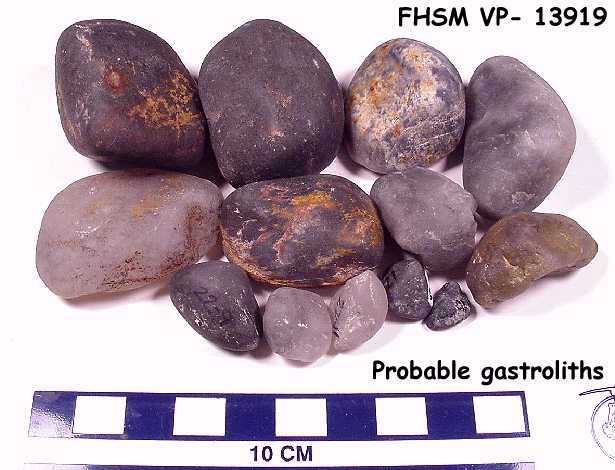| March 8, 1912]
SCIENCE
377THE "STOMACH STONES" OF REPTILES
Gastroliths have been known to occur, mingled with the
remains of extinct reptiles, for many years and much attention has been called to them in
the pages of SCIENCE and elsewhere, especially by Mudge,
Seeley, Williston, Eastman, Wieland and Brown. Interesting parallels have been cited among
several living vertebrates. There has been some contention that the stones were taken for
the purpose of a "gastric mill," but they were in part at least accidental.
There seems to be some evidence for the conclusion that the plesiosaurs, at least,
selected stones for this purpose, though this may have been more accidental than we think.
Recently there has been brought to my attention by Mr. Edward Taylor, of the University of
Kansas, au interesting case of stone swallowing by a lizard,. Phrynosoma cornutum
Harlan. Only a single specimen is at hand for the data, but it is of sufficient interest
in connection with identical habits among fossil reptiles to be recorded. The horned
"toad" in question is a very large adult female collected by the late Dr. F. H.
Snow in the Magdalen Mountains of New Mexico. In the stomach were twenty large, somewhat
abraded stones of a rock which resembled lava. Some of the stones are very large, for the
size of the animal, measuring nearly a third of an inch in diameter. There were also in
the stomach about 200 of the large red ants, of an undetermined species, which make the
large mounds so common to the western traveler. The animal had undoubtedly picked up the
stones with the ants from the top of the mound and the association is probably accidental.
That they served the purpose of a "gastric mill " once inside the digestive
canal can not be doubted, whether the animal willed or no.
In this connection it may be of interest to the readers
of these pages to call attention to some large Cretaceous sharks which have, within the
past few months, been received at the University of Kansas Museum. In one specimen [KUVP 68979], consisting
almost entirely of scattered vertebral cartilages, there are associated many hundreds of
greatly abraded, very smooth and polished stones of white and black
quartzite.
378
SCIENCE
[N. S. Vol. XXXV. No. 897
That they belong with the shark can not be
doubted on account of the association. The pebbles resemble to a great extent those
figured by Dr. Williston some years ago as occurring with a pleisosaur [sic]. Another,
nearly complete skeleton of a large shark, Isurus mantelli Ag., [KUVP 247] has
preserved the larger part of the cranial cartilages. The sharks will shortly be described
in detail and further reference need not be made to them here.
Roy L. Moodie
THE UNIVERSITY OF KANSAS ,
January 26, 1912 |

